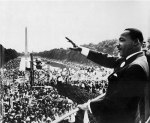(Bob Morris posted this on his blog this morning, The Dueling Myths of Business, and it kind of prompted the thoughts that follow).
—————
Over the past 15 years, I have immersed myself in the literature of building and sustaining a successful business. Certain “lasting truths” have stood out and stood up.
Here’s one. At the heart of a successful organization is the narrative, the story, of the key decisions and key moments and key people that made that organization so successful. These are the “myths” of the organization. For example, think Herb Kelleher, and his fanatic commitment to his employees at Southwest Airlines. The “stories” are the stuff of legend.
 When I teach my speech students about logos, ethos, and pathos, I also teach about mythos. Mythos, the “narrative appeal,” is a powerful appeal. One place to see this is in the great speech by Martin Luther King, Jr., I Have a Dream. In that speech, he accuses the United States government of being unfaithful to its foundational story, its myth:
When I teach my speech students about logos, ethos, and pathos, I also teach about mythos. Mythos, the “narrative appeal,” is a powerful appeal. One place to see this is in the great speech by Martin Luther King, Jr., I Have a Dream. In that speech, he accuses the United States government of being unfaithful to its foundational story, its myth:
It is obvious today that America has defaulted on this promissory note, insofar as her citizens of color are concerned. Instead of honoring this sacred obligation, America has given the Negro people a bad check, a check which has come back marked “insufficient funds.”
It is a powerful image. One that sticks. And one that worked because Dr. King was simply and powerfully making this point (in my words): “You know the story of America. The way people of color are treated is a violation of that story. It’s time to change that – to be true to our story.”
So, at the heart of mythos, the narrative appeal, is “myth.” What is “myth?” I really do not know if these are my words, or borrowed from a book or speaker from long ago, but this is how I define myth to my students:
“A myth is a story that is true – whether it is true or not.”
Here’s the example that I use with my students:
Have you ever known anyone who did something really stupid because he or she simply was not thinking?
Have you ever known anyone who just did not seem to care for other people – he/she had some kind of compassion deficit?
Have you ever known anyone who, in a moment of testing, did not find the courage to take the right stand?What story did I just tell? (Few of my students get it in this first run trhough).
(So I say)
Try it this way:
If that person only had a brain.
If that person only had a heart.
If that person only had courage.Now, what story am I telling?
 Practically every student then says The Wizard of Oz. You see, it does not matter that there wasn’t a real Dorothy, or a real land of Oz. That story is true, whether it is a “true” story or not. We all need to be people who have, and use, our brains, our hearts, our courage.
Practically every student then says The Wizard of Oz. You see, it does not matter that there wasn’t a real Dorothy, or a real land of Oz. That story is true, whether it is a “true” story or not. We all need to be people who have, and use, our brains, our hearts, our courage.
Now, in building organizational culture, story trumps practically any other kind of message. Tell the stories of struggle. Tell the stories of success. And when there are keystone stories, foundational stories, tell them and retell them, over and over, so that every one knows: “this is who we are.”
Telling the story, the myth, of an organization helps build, maintain, and keep alive, the very core truth behind an organization. And people really do need to know, and cherish, that core truth – that myth.
